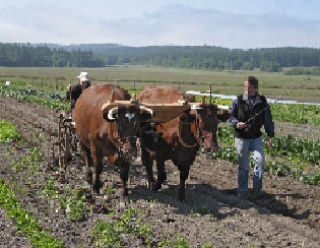Drive along Baker View Road on Lopez toward Spencer Spit and it’s likely that you’ll see a car or two pulled over and people taking pictures of Ken Akopiantz leading a team of oxen yoked to a cultivator and Kathryn Thomas sitting on the cultivator guiding it through the rows of vegetables.
Hoping for more than a photo, I called Ken and Kathryn, owners of Horse Drawn Farms, and asked them to tell me about farming with oxen. Their affection for Giz and Red, the much-photographed oxen, came through in everything they told me.
“I’ll brush them a little more than usual since you’re here,” Ken said to me one early morning recently as he smoothed a few small patches of mud from Red’s flank and then turned to brush Giz. “These are milking shorthorns,” he explained. “In this country the technical definition of an ox is a four-year-old steer that knows how to work. These guys just turned three. When they turn four they graduate and become oxen.”
“They’re pretty gentle,” he added as we scratched them behind their horns, “and they really like attention. I stop to pat them when we’re in the field. You’ve heard the phrase steady as an ox? It’s true. They are pretty dependable critters. They are happy to stand still. They are happy to go if I tell them.”
In a soft, even voice, he said: “Back, back, back, haw,” and Red and Giz stepped backwards and then right. Ken used a goad, a thin, black wand, but it seemed to be his voice that guided the oxen out of their stall and into the barnyard.
“Aren’t they cool!” Kathryn said as she joined us and we all headed out to the field where Red and Giz stood patiently as Ken attached the cultivator to their yoke. I noticed the wire muzzles buckled over Red and Giz’s mouths and Kathryn explained, laughing, “Giz really likes brassicas. And Red likes corn.” The muzzles are typical for oxen because they walk with their heads down and all those vegetables are tempting.
Then they went to work, Ken leading the team and Kathryn guiding the cultivator to mark new rows. I followed, amazed to see how precisely these large animals stepped along the paths, their hooves just missing rows of spinach, fennel, onions, broccoli and lettuces.
Then it was my turn on the cultivator. You can tell how much people like their animals when they want to share the pleasure of working with them. With Kathryn leading, I tried to steer in the straight path set by Giz and Red. “They started out ‘oh my God I can’t pull this thing,’” Kathryn remembered, “but by the end of the first day they were doing fine.”
Not only do the oxen make cultivating diesel-free, Giz and Red could also put up their own hay. “We do feed them stored hay,” Kathryn said, “but we’ve talked about doing loose hay because they could it all. They’ve mowed before, they could rake, and they could run the loose hay loader.”
The new rows set, Red and Giz were done for the morning and Kathryn and I walked them back to the barn. “Red is smart,” Kathryn said, “really responsive, quick. And he’ll take every opportunity to poke his horns at his brother, just a little ‘I’m in charge’ poke,” she said smiling. “Giz doesn’t really care. He’s the guy with the funny personality, happy-go-lucky. I like him.”
Earlier, while they were cultivating, Ken said: “everyone should have oxen.” After my morning with Red and Giz, I had to agree.



